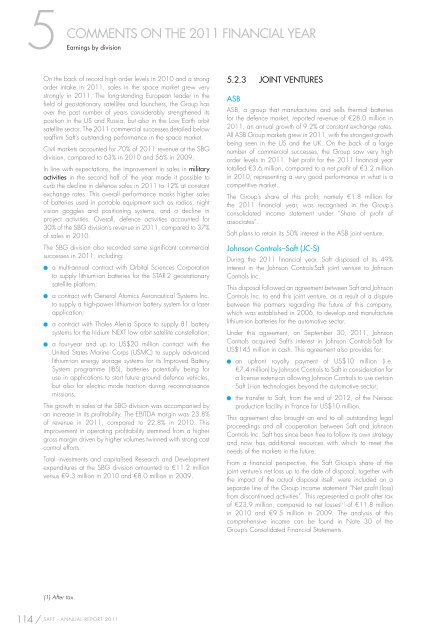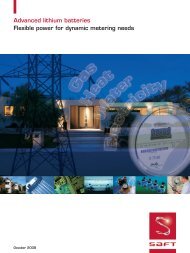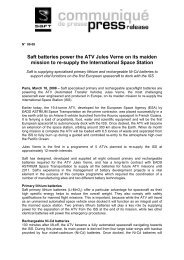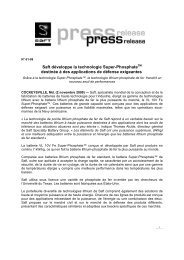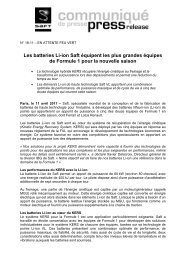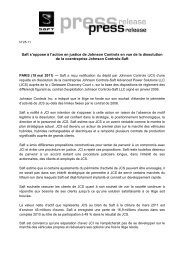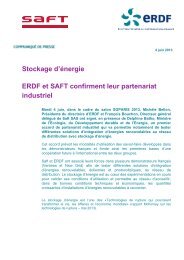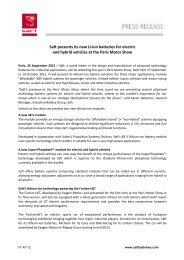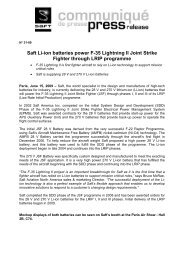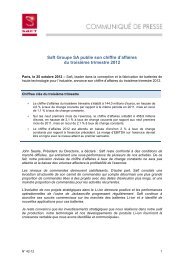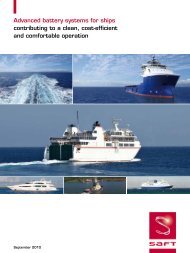ANNUAL REPORT 2011 REGISTRATION DOCUMENT - Saft
ANNUAL REPORT 2011 REGISTRATION DOCUMENT - Saft
ANNUAL REPORT 2011 REGISTRATION DOCUMENT - Saft
Create successful ePaper yourself
Turn your PDF publications into a flip-book with our unique Google optimized e-Paper software.
5 Earnings<br />
COMMENTS ON THE <strong>2011</strong> FINANCIAL YEAR<br />
by division<br />
On the back of record high order levels in 2010 and a strong<br />
order intake in <strong>2011</strong>, sales in the space market grew very<br />
strongly in <strong>2011</strong>. The long-standing European leader in the<br />
fi eld of geostationary satellites and launchers, the Group has<br />
over the past number of years considerably strengthened its<br />
position in the US and Russia, but also in the Low Earth orbit<br />
satellite sector. The <strong>2011</strong> commercial successes detailed below<br />
reaffi rm <strong>Saft</strong>’s outstanding performance in the space market.<br />
Civil markets accounted for 70% of <strong>2011</strong> revenue at the SBG<br />
division, compared to 63% in 2010 and 56% in 2009.<br />
In line with expectations, the improvement in sales in military<br />
activities in the second half of the year made it possible to<br />
curb the decline in defence sales in <strong>2011</strong> to 12% at constant<br />
exchange rates. This overall performance masks higher sales<br />
of batteries used in portable equipment such as radios, night<br />
vision goggles and positioning systems, and a decline in<br />
project activities. Overall, defence activities accounted for<br />
30% of the SBG division’s revenue in <strong>2011</strong>, compared to 37%<br />
of sales in 2010.<br />
The SBG division also recorded some signifi cant commercial<br />
successes in <strong>2011</strong>, including:<br />
� a multi-annual contract with Orbital Sciences Corporation<br />
to supply lithium-ion batteries for the STAR-2 geostationary<br />
satellite platform;<br />
� a contract with General Atomics Aeronautical Systems Inc.<br />
to supply a high-power lithium-ion battery system for a laser<br />
application;<br />
� a contract with Thales Alenia Space to supply 81 battery<br />
systems for the Iridium NEXT low orbit satellite constellation;<br />
� a four-year and up to US$20 million contract with the<br />
United States Marine Corps (USMC) to supply advanced<br />
lithium-ion energy storage systems for its Improved Battery<br />
System programme (IBS), batteries potentially being for<br />
use in applications to start future ground defence vehicles,<br />
but also for electric mode traction during reconnaissance<br />
missions.<br />
The growth in sales at the SBG division was accompanied by<br />
an increase in its profi tability. The EBITDA margin was 23.8%<br />
of revenue in <strong>2011</strong>, compared to 22.8% in 2010. This<br />
improvement in operating profi tability stemmed from a higher<br />
gross margin driven by higher volumes twinned with strong cost<br />
control efforts.<br />
Total investments and capitalised Research and Development<br />
expenditures at the SBG division amounted to €11.2 million<br />
versus €9.3 million in 2010 and €8.0 million in 2009.<br />
(1) After tax.<br />
114 / SAFT - <strong>ANNUAL</strong> <strong>REPORT</strong> <strong>2011</strong><br />
5.2.3 JOINT VENTURES<br />
ASB<br />
ASB, a group that manufactures and sells thermal batteries<br />
for the defence market, reported revenue of €28.0 million in<br />
<strong>2011</strong>, an annual growth of 9.2% at constant exchange rates.<br />
All ASB Group markets grew in <strong>2011</strong>, with the strongest growth<br />
being seen in the US and the UK. On the back of a large<br />
number of commercial successes, the Group saw very high<br />
order levels in <strong>2011</strong>. Net profi t for the <strong>2011</strong> fi nancial year<br />
totalled €3.6 million, compared to a net profi t of €3.2 million<br />
in 2010, representing a very good performance in what is a<br />
competitive market.<br />
The Group’s share of this profi t, namely €1.8 million for<br />
the <strong>2011</strong> fi nancial year, was recognised in the Group’s<br />
consolidated income statement under “Share of profi t of<br />
associates”.<br />
<strong>Saft</strong> plans to retain its 50% interest in the ASB joint venture.<br />
Johnson Controls–<strong>Saft</strong> (JC-S)<br />
During the <strong>2011</strong> fi nancial year, <strong>Saft</strong> disposed of its 49%<br />
interest in the Johnson Controls-<strong>Saft</strong> joint venture to Johnson<br />
Controls Inc.<br />
This disposal followed an agreement between <strong>Saft</strong> and Johnson<br />
Controls Inc. to end this joint venture, as a result of a dispute<br />
between the partners regarding the future of this company,<br />
which was established in 2006, to develop and manufacture<br />
lithium-ion batteries for the automotive sector.<br />
Under this agreement, on September 30, <strong>2011</strong>, Johnson<br />
Controls acquired <strong>Saft</strong>’s interest in Johnson Controls-<strong>Saft</strong> for<br />
US$145 million in cash. This agreement also provides for:<br />
� an upfront royalty payment of US$10 million (i.e.<br />
€7.4 million) by Johnson Controls to <strong>Saft</strong> in consideration for<br />
a license extension allowing Johnson Controls to use certain<br />
<strong>Saft</strong> Li-ion technologies beyond the automotive sector;<br />
� the transfer to <strong>Saft</strong>, from the end of 2012, of the Nersac<br />
production facility in France for US$10 million.<br />
This agreement also brought an end to all outstanding legal<br />
proceedings and all cooperation between <strong>Saft</strong> and Johnson<br />
Controls Inc. <strong>Saft</strong> has since been free to follow its own strategy<br />
and now has additional resources with which to meet the<br />
needs of the markets in the future.<br />
From a fi nancial perspective, the <strong>Saft</strong> Group’s share of the<br />
joint venture’s net loss up to the date of disposal, together with<br />
the impact of the actual disposal itself, were included on a<br />
separate line of the Group income statement “Net profi t (loss)<br />
from discontinued activities”. This represented a profi t after tax<br />
of €23.9 million, compared to net losses (1) of €11.8 million<br />
in 2010 and €9.5 million in 2009. The analysis of this<br />
comprehensive income can be found in Note 30 of the<br />
Group’s Consolidated Financial Statements.


